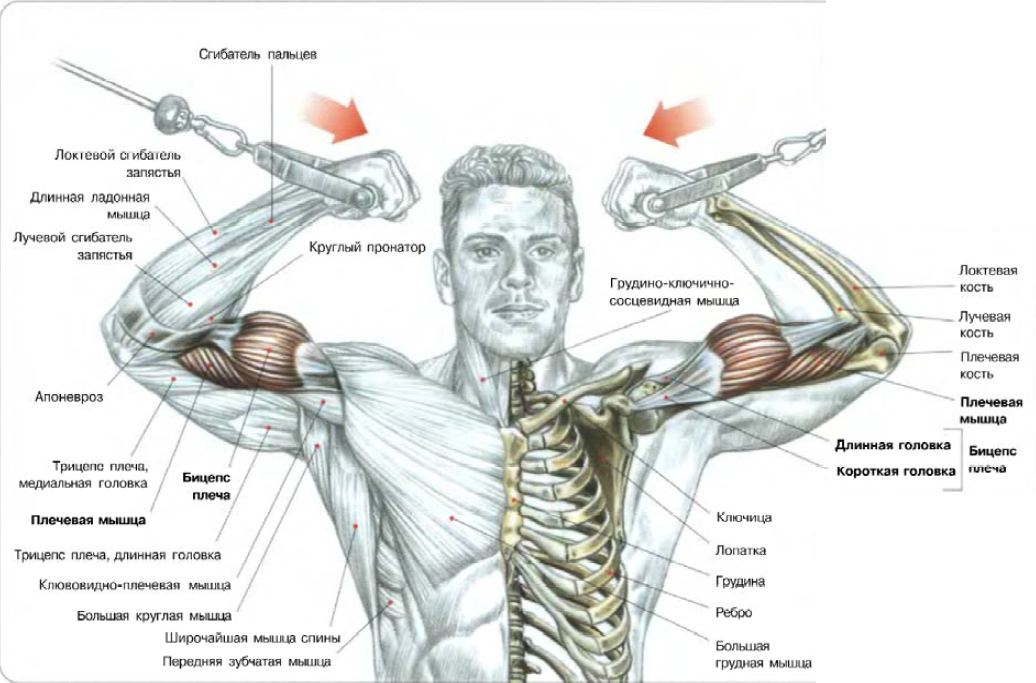Ah, good old direct arm training. The common practice of every bodybuilder everywhere who ever wanted to get maximally big and inhumanely strong.
Only, it seems that such once all-powerful workouts have fallen out of favor lately, especially with the emergence of terms like “functional training” and “risk of overtraining”.
Regular weight lifting programs were making bodies incredibly more “functional” long before the rise of a trendy fitness branch with that name, and while it’s true that too much overall arm work can screw up your gains, overtraining is a phenomena most reliably observed in advanced lifters and it happens very, very rarely.
Also, if you really want to sculpt muscular arms in this lifetime, you will never be able to do it without doing direct biceps and triceps work.
If now you’re thinking “Isn’t my back routine already exhausting my bi’s?” Although it’s true that every time you perform a back exercise which involves elbow flexion, you’re engaging your biceps, this is far from enough to overload your bi’s, even with the added effect of bicep involvement in chest and shoulder training (suppose you do those regularly).
Those arm muscle fibers need strong and direct stimuli to activate their growth potential, and you simply can’t do very well that if you’re only training them as an afterthought.
However, don’t forget that the overall stress of bicep and triceps involvement as secondary muscles in exercises which primarily target other body parts is still somewhat cumulative and it can unfavorably increase catabolism (muscle breakdown), so you should still be careful about the volume of direct and indirect work you do.
Rep ranges for biceps growth
Many gym enthusiasts would tell you that high rep weight training is the best route for making your biceps grow. Then again, the rest of the gym-world would be proud to present that they prefer using low reps with heavier weights for a more deeply muscle-damaging workout.
Which group is right? Well, both are!
Unfortunately, none of them is getting the most out of their workout, because using only one rep range when training your arms is pretty much like using only one isolation exercise to effectively develop a major muscle group.
Different rep ranges target different muscle fibers, or components of the muscle tissue, so training in one rep range for too long will only limit your growth.
In other words, any bodybuilder who wants huge, strong and well-developed arms must include an adequate amount of variety of stimuli in his training, with switching the rep range being one of the best ways to do that.
That being said, the general rule of thumb when training for maximum arm size is to aim to activate multiple growth mechanisms at each training session by spending one-third of your sessions doing low reps, one-third doing moderate reps and one-third doing high-rep sets.
Therefore, if you’re still used to only doing 3 sets of 10 reps for your bi’s, you should snap out of your rut right now and make sure to start giving proper attention to this special muscle group. Here’s how.
3 REP RANGES FOR BIGGER BICEPS
Here we have 3 sample combos of different rep ranges and rest periods that you can use to exhaust your muscles as thoroughly as possible.
These are three of the most effective variants for a full bicep attack, but you could also modify them according to your needs. Just keep in mind that the number of reps and amount of rest between sets should stay inversely proportional.
For best results, we recommend you to either spend a few weeks using one set and rep scheme at a time before moving on to the next one, or do all three in the same workout.
1. Max. Mechanical Tension
If you’re looking to enhance protein synthesis, you need to increase the mechanical tension placed on the muscle, and this can be achieved by training in the following pattern: 5 sets x 5 reps, 120 seconds rest
2. Max. Metabolic Fatigue
Metabolic stress is one of the three mechanisms of hypertrophy, together with mechanical tension and muscle damage, so you definitely want it as a factor in your training plan. To maximize metabolic fatigue, train like this: 3 sets x 8-12 reps, 75 seconds rest
3. The Middle Way
But if your goal is somewhere in the middle between the extremes, there is a sweet training spot for you too: 4 sets x 12-15 reps, 30 seconds rest
This is only one part of what is required for designing a super-effective arm workout, but it’s also one major step towards it.
If you’re already tired of your lifeless 3 x 10 straight set routines which don’t seem to lead you anywhere significant, give these 3 combos a try and you could see some great arm development in no time.
